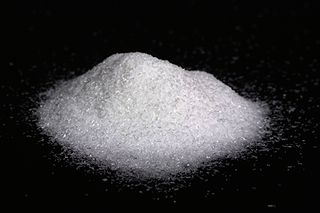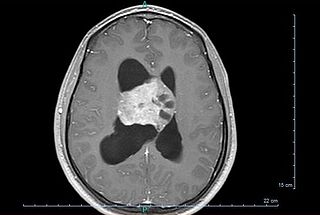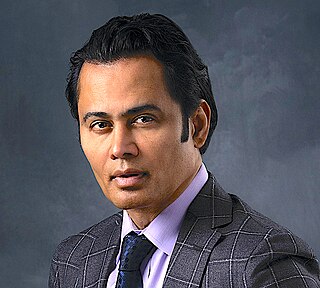Related Research Articles

Aspartame is an artificial non-saccharide sweetener 200 times sweeter than sucrose and is commonly used as a sugar substitute in foods and beverages. It is a methyl ester of the aspartic acid/phenylalanine dipeptide with brand names NutraSweet, Equal, and Canderel. Aspartame was approved by the US Food and Drug Administration (FDA) in 1974, and then again in 1981, after approval was revoked in 1980.

Neurosurgery or neurological surgery, known in common parlance as brain surgery, is the medical specialty concerned with the surgical treatment of disorders which affect any portion of the nervous system including the brain, spinal cord and peripheral nervous system.

Sucralose is an artificial sweetener and sugar substitute. As the majority of ingested sucralose is not metabolized by the body, it adds no calories. In the European Union, it is also known under the E number E955. It is produced by chlorination of sucrose, selectively replacing three of the hydroxy groups—in the C1 and C6 positions of the fructose portion and the C4 position of the glucose portion—to give a 1,6-dichloro-1,6-dideoxyfructose–4-chloro-4-deoxygalactose disaccharide. Sucralose is about 600 times sweeter than sucrose, three times as sweet as both aspartame and acesulfame potassium, and twice as sweet as sodium saccharin.

Splenda is a global brand of sugar substitutes and reduced-calorie food products. While the company is known for its original formulation containing sucralose, it also manufactures items using natural sweeteners such as stevia, monk fruit and allulose. It is owned by the American company Heartland Food Products Group. The high-intensity sweetener ingredient sucralose used in Splenda Original is manufactured by the British company Tate & Lyle.

A sugar substitute is a food additive that provides a sweetness like that of sugar while containing significantly less food energy than sugar-based sweeteners, making it a zero-calorie or low-calorie sweetener. Artificial sweeteners may be derived through manufacturing of plant extracts or processed by chemical synthesis. Sugar substitute products are commercially available in various forms, such as small pills, powders, and packets.

Monosodium glutamate (MSG), also known as sodium glutamate, is a sodium salt of glutamic acid. MSG is found naturally in some foods including tomatoes and cheese in this glutamic acid form. MSG is used in cooking as a flavor enhancer with a savory taste that intensifies the meaty, savory flavor of food, as naturally occurring glutamate does in foods such as stews and meat soups.

Acesulfame potassium, also known as acesulfame K or Ace K, is a synthetic calorie-free sugar substitute often marketed under the trade names Sunett and Sweet One. In the European Union, it is known under the E number E950. It was discovered accidentally in 1967 by German chemist Karl Clauss at Hoechst AG. In chemical structure, acesulfame potassium is the potassium salt of 6-methyl-1,2,3-oxathiazine-4(3H)-one 2,2-dioxide. It is a white crystalline powder with molecular formula C
4H
4KNO
4S and a molecular weight of 201.24 g/mol.

Diet or light beverages are generally sugar-free, artificially sweetened beverages with few or no calories. They are marketed for diabetics and other people who want to reduce their sugar and/or caloric intake.

Meningioma, also known as meningeal tumor, is typically a slow-growing tumor that forms from the meninges, the membranous layers surrounding the brain and spinal cord. Symptoms depend on the location and occur as a result of the tumor pressing on nearby tissue. Many cases never produce symptoms. Occasionally seizures, dementia, trouble talking, vision problems, one sided weakness, or loss of bladder control may occur.

In excitotoxicity, nerve cells suffer damage or death when the levels of otherwise necessary and safe neurotransmitters such as glutamate become pathologically high, resulting in excessive stimulation of receptors. For example, when glutamate receptors such as the NMDA receptor or AMPA receptor encounter excessive levels of the excitatory neurotransmitter, glutamate, significant neuronal damage might ensue. Excess glutamate allows high levels of calcium ions (Ca2+) to enter the cell. Ca2+ influx into cells activates a number of enzymes, including phospholipases, endonucleases, and proteases such as calpain. These enzymes go on to damage cell structures such as components of the cytoskeleton, membrane, and DNA. In evolved, complex adaptive systems such as biological life it must be understood that mechanisms are rarely, if ever, simplistically direct. For example, NMDA in subtoxic amounts induces neuronal survival of otherwise toxic levels of glutamate.

Radiosurgery is surgery using radiation, that is, the destruction of precisely selected areas of tissue using ionizing radiation rather than excision with a blade. Like other forms of radiation therapy, it is usually used to treat cancer. Radiosurgery was originally defined by the Swedish neurosurgeon Lars Leksell as "a single high dose fraction of radiation, stereotactically directed to an intracranial region of interest".

The anterior clinoid process is a posterior projection of the sphenoid bone at the junction of the medial end of either lesser wing of sphenoid bone with the body of sphenoid bone. The bilateral processes flank the sella turcica anteriorly.
The artificial sweetener aspartame has been the subject of several controversies since its initial approval by the U.S. Food and Drug Administration (FDA) in 1974. The FDA approval of aspartame was highly contested, beginning with suspicions of its involvement in brain cancer, alleging that the quality of the initial research supporting its safety was inadequate and flawed, and that conflicts of interest marred the 1981 approval of aspartame, previously evaluated by two FDA panels that concluded to keep the approval on hold before further investigation. In 1987, the U.S. Government Accountability Office concluded that the food additive approval process had been followed properly for aspartame. The irregularities fueled a conspiracy theory, which the "Nancy Markle" email hoax circulated, along with claims—counter to the weight of medical evidence—that numerous health conditions are caused by the consumption of aspartame in normal doses.

Glutamate flavoring is the generic name for flavor-enhancing compounds based on glutamic acid and its salts (glutamates). These compounds provide an umami (savory) taste to food.
John Olney was a medical doctor and a professor of psychiatry, pathology, and immunology at the Washington University School of Medicine. He is known for his work on brain damage. He coined the term excitotoxicity in his 1969 paper published in Science. Olney's lesions are named after him. In 1996 he was elected to the Institute of Medicine of the United States National Academy of Sciences. He had campaigned for greater regulation of monosodium glutamate (MSG), aspartame and other excitotoxins for over twenty years. He died at his residence on April 14, 2015 at the age of 83.
Ludwig G. Kempe was an American neurosurgeon, author and illustrator.

Central neurocytoma (CNC) is an extremely rare, ordinarily benign intraventricular brain tumour that typically forms from the neuronal cells of the septum pellucidum. The majority of central neurocytomas grow inwards into the ventricular system forming interventricular neurocytomas. This leads to two primary symptoms of CNCs, blurred vision and increased intracranial pressure. Treatment for a central neurocytoma typically involves surgical removal, with an approximate 1 in 5 chance of recurrence. Central neurocytomas are classified as a grade II tumor under the World Health Organization's classification of tumors of the nervous system.

Aaron A. Cohen-Gadol is a professor of neurological surgery in the department of neurosurgery at Indiana University School of Medicine and a neurosurgeon at Indiana University Health specializing in the surgical treatment of complex brain tumors, vascular malformations, cavernous malformations, etc. He performs removal of brain tumors via minimally invasive endoscopic techniques, which use the nasal pathways instead of opening the skull.

Saleem Abdulrauf is an American physician specializing in neurosurgery in Washington, DC, who has helped develop high-flow brain bypass surgery, a less invasive procedure for treating intracranial aneurysm than methods used previously.
The Dextroscope is a medical equipment system that creates a virtual reality (VR) environment in which surgeons can plan neurosurgical and other surgical procedures.
References
- 1 2 "Russell Blaylock Seminar Series at Belhaven College" (PDF). Archived from the original (PDF) on 2013-03-13. Retrieved 2014-03-17.
- 1 2 Magnuson BA, Burdock GA, Doull J, et al. (2007). "Aspartame: a safety evaluation based on current use levels, regulations, and toxicological and epidemiological studies". Crit. Rev. Toxicol. 37 (8): 629–727. doi:10.1080/10408440701516184. PMID 17828671. S2CID 7316097.
- 1 2 Walker R, Lupien JR (2000). "The safety evaluation of monosodium glutamate". Journal of Nutrition. 130 (4S): 1049S–52S. doi: 10.1093/jn/130.4.1049S . PMID 10736380.
- ↑ "Russell Blaylock's website". Russellblaylockmd.com. Archived from the original on 2014-05-31. Retrieved 2010-01-13.
- ↑ "North Carolina Medical Board". Docboard.org. Archived from the original on 2010-01-27. Retrieved 2010-01-13.
- ↑ Jun, Cecil L.; Nutik, Stephen L. (March 1985). "Surgical Approaches to Intraventricular Meningiomas of the Trigone". Neurosurgery. 16 (3): 416–420. doi:10.1227/00006123-198503000-00025. PMID 3982626.
- ↑ Kempe LG, Blaylock R (1976). "Lateral-trigonal intraventricular tumors. A new operative approach". Acta Neurochir (Wien). 35 (4): 233–42. doi:10.1007/bf01406119. PMID 998353. S2CID 31659187.
- ↑ "Belhaven University website". Belhaven.edu. Archived from the original on 2010-01-17. Retrieved 2010-01-13.
- ↑ "An Irresistible Force?". aapsonline.org. Archived from the original on 2011-06-06. Retrieved 2009-10-17.
- ↑ A game of hide and seek. (hidden MSG in processed foods) originally printed in Vegetarian Times, September 01, 1998 AccessMyLibrary record.
- ↑ "Want full disclosure with that meal? St. Petersburg Times September 25, 2005". Sptimes.com. Archived from the original on 2010-01-06. Retrieved 2010-01-13.
- ↑ Pratt, Steven (1994-07-28). "FLAVOR-ENHANCING MSG IS EVERYWHERE, BUT IS IT HARMLESS OR AN "EXCITOTOXIN"? Chicago Tribune July 28, 1994". Pqasb.pqarchiver.com. Archived from the original on 2012-10-22. Retrieved 2010-01-13.
- ↑ "Sugar substitutes aren't always so healthy The Free Lance-Star September 10, 2001". Fredericksburg.com. 2001-10-09. Archived from the original on 2012-03-07. Retrieved 2010-01-13.
- ↑ "How sweet it isn't? Natural alternatives to sugar, minus the calories and carcinogens.(Eating Right) E Magazine November 01, 2003". Accessmylibrary.com. 2003-11-01. Retrieved 2010-01-13.
- ↑ Excitotoxins: The Taste That Kills Health Press, 1994. ISBN 0-929173-14-7
- ↑ Gogoi, Pallavi, edited by Beth Belton. How Far from Sugar Is Splenda? Archived 2010-01-11 at the Wayback Machine , BusinessWeek Online, McGraw Hill, February 2, 2005. Retrieved 2009-10-15.
- ↑ Grice HC, Goldsmith LA (2000). "Sucralose--an overview of the toxicity data". Food Chem Toxicol. 38 (Suppl 2): S1–6. doi:10.1016/S0278-6915(00)00023-5. PMID 10882813.
- 1 2 3 Schwarcz, Joe (8 November 2009). "it's all a plot to anti-vaccination conspiracy nuts". Montreal Gazette. Archived from the original on 16 January 2014. Retrieved 12 June 2013.
- ↑ Blaylock, Russell (22 April 2022). "COVID UPDATE: What is the truth?". Surgical Neurology International. 13: 167. doi:10.25259/SNI_150_2022. PMC 9062939 . PMID 35509555.